Desert Storm: Experiencing Dakar 2022 on the ground
It’s 20°C and there isn’t a cloud in the sky – although that’s to be expected in Saudi Arabia in January. James Elson packs his T-shirts to follow the dune duels of the 2022 Dakar Rally
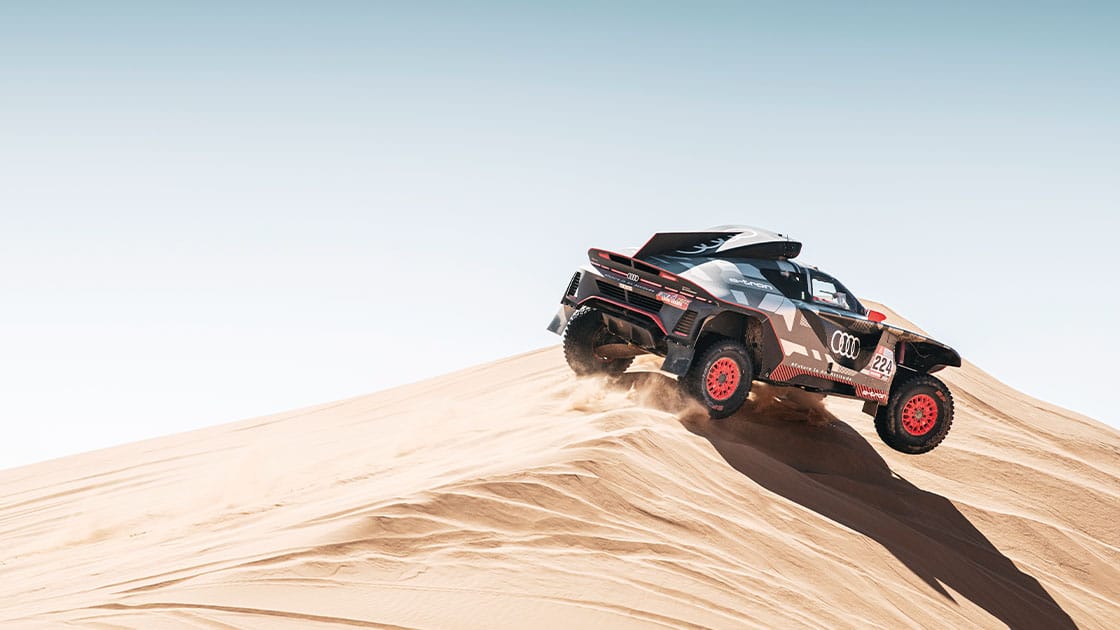
DPPI
The elderly Spanish-speaking couple I’m sharing the 4×4 with start to fret. I’m not in the best frame of mind either. Our local driver doesn’t seem unduly bothered though, and despite urges from my companions for him to change direction, he takes us along what to all intents and purposes is the racing line through the desert from one Dakar Rally spectator viewing point to another – while the stage is live.
Hearing the high-pitched whining of a turbo, I peer out the dusty back window of our Toyota Land Cruiser to see an off-road prototype bearing down on us at some rate of knots as dust plumes up behind it.
“Turn left!” I tell the driver, who finally acquiesces, with the top-class Dakar Rally competitor thundering past us shortly after, a little too close for comfort. Our driver then returns back to his original line, as if nothing had ever happened.
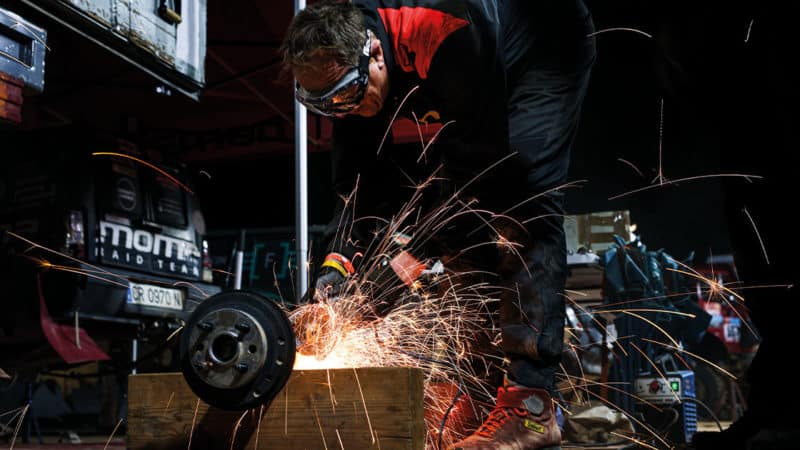
Busy mechanic of Moma Raid, which ran a Fiat Panda 4×4 and Pegaso truck.
DPPI
A little earlier, we witnessed Sébastien Loeb and Nasser Al-Attiyah tear through the arid landscape side by side as they duelled for the lead, and not long later we’ll see a gigantic Kamaz truck driver barely take his foot off the throttle as he threads through a 100-strong herd of camels.
It’s only just past noon on my first day at the weird, wonderful and sometimes worrying Dakar Rally, where the truly extraordinary becomes an everyday occurrence for two weeks, this year between January 1 and 14.
Described by Loeb’s Prodrive boss David Richards as “the Everest of motor sport”, the event is arguably the most intense and gruelling driving challenge in the world – 5000 miles in total, with 2500 of those run as competitive ‘special stages’ through Saudi Arabia’s unforgiving desert terrain. Drivers negotiate gigantic boulders on some tests and towering sand dunes on the next.

BRX Hunter T1+ of Sébastien Loeb; this was his sixth Dakar
DPPI
There are five main vehicle categories (six if you include the Classic event): Cars, Bikes, Quads, Trucks and Lightweights (essentially buggies) with subdivisions of each of these classes, with some catering for bespoke prototype rally cars and others converted production models.
In total 551 vehicles take part this year, with drivers and riders starting at two-minute intervals in order of classes, with the cars going first. The rally therefore represents some kind of motorised version of a David Attenborough natural-history documentary as bikes leap past trucks while buggies scurry in between.
As well as the rock-solid reliability required, navigation provided by the co-driver is crucial, with competitors often getting lost in attempting to locate waypoints – a number of predefined locations which link the start of the stage to the end – while also trying to beat the clock.
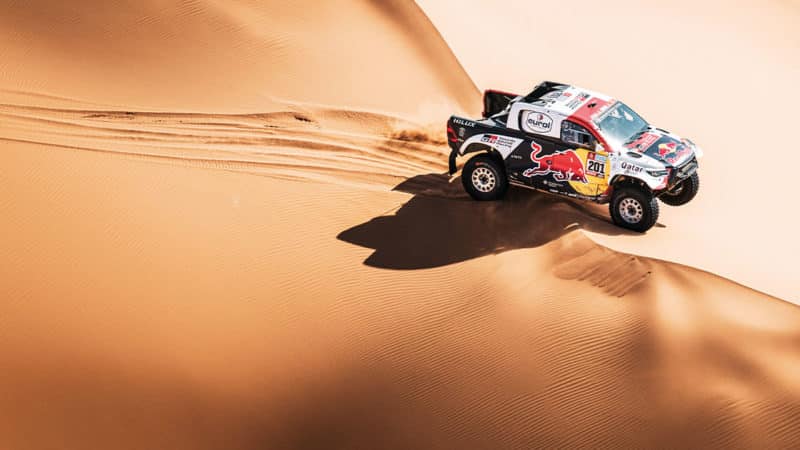
Qatari driver Nasser Al-Attiyah took his fourth Dakar win, and his second for Toyota, in the Hilux
DPPI

Chile’s Francisco López Contardo at Dakar 2022
DPPI
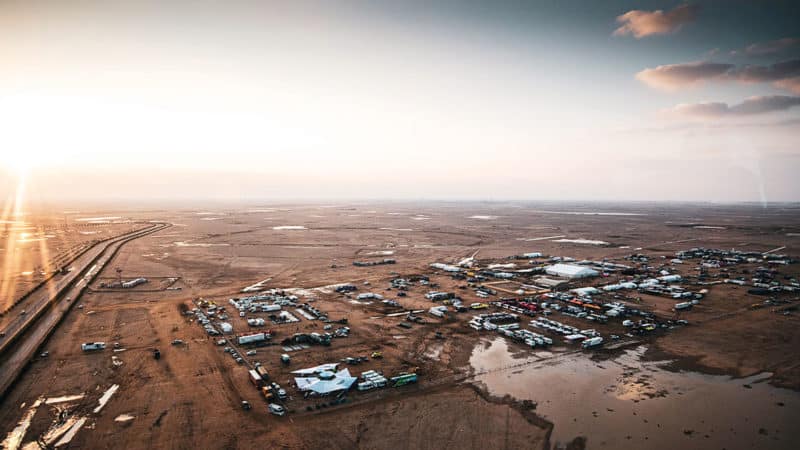
Bivouac-y racers: the moving city at Dakar’s second stage following a desert downpour.
DPPI
If fans want to push the boat out to the extent of flying out to Riyadh and hiring a car to find the best viewing spots, then Dakar offers perhaps the most visceral, non-sanitised elite-level motor sport experience out there. Not only that but being on the ground at the Dakar really does give the impression of landing on a lost Star Wars planet.
The sharp sun is low and the wind whips across the rocky desert landscape as a delightful variety of machinery pulls up to take the start line with officials, journalists and a collection of excited locals jumping up and down to keep warm on the spot.
The sheer motoring diversity on show – even in the fastest T1 car class alone – recalls bygone eras of rallying, F1 and sports cars.
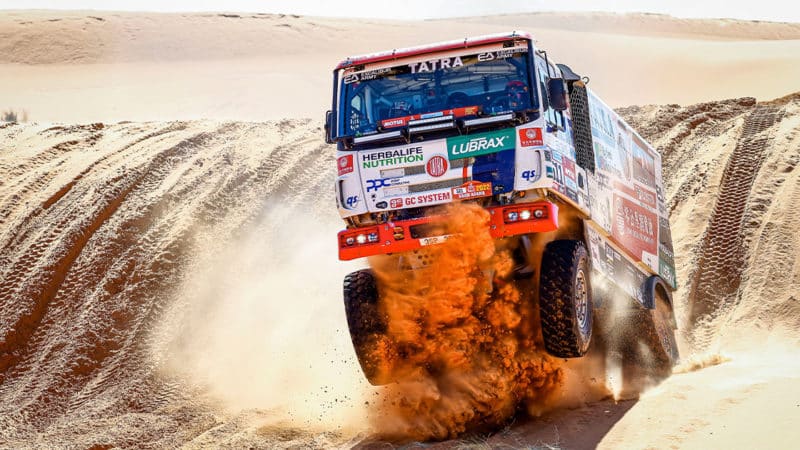
The Tatra of Ignacio Casale, Álvaro León and Tomas Sikola was 75 hours off the pace of the winning Kamaz
Eventual rally winner Nasser Al-Attiyah’s brutal Toyota Hilux – looking like it’s just pulled out of your local Saudi Toyota dealer via a quick Red Bull-themed paint job – screams off from under the starting gantry before tearing across the desert, while Loeb’s menacing Prodrive BRX Hunter machine is slightly more sonically reserved – its 3.5-litre Ford V6 growls as the Frenchman floors it.
The Audi RS Q e-tron on the other hand is a different prospect entirely, being the sporting poster child for the German marque’s move towards the electrification of its road cars. Its three Formula E-derived MGUs give the car a familiar whirr as we watch Carlos Sainz set off, but witness the car later and we can also hear its repurposed DTM ICU working to recharge the batteries, set to run somewhere between 4500 and 6000rpm.
The slightly surreal sound of the engine running at a constant resembles a cross between a Dyson hoover and a cross-Channel SRN4 hovercraft pulling into Dover.

A baptism of sand for Stéphane Peterhansel’s Audi RS Q e-tron
DPPI
The Audi team has experienced all the highs and lows Dakar has to offer in one event. A sickening crash for Stéphane Peterhansel on the first stage put him out of the reckoning, with the team also suffering multiple damper issues for Sainz, his rear wheel flying comically off after its fatigued driver crew did not reattach it properly. “We managed reliability on paper but not in reality,” comments Audi team principal Sven Quandt at the event.
However, the car clearly has serious pace, and while they’re out of contention for the overall win, all three of its drivers – Sainz, Peterhansel and former DTM champion Mattias Ekström – claim stage wins.
“There are grumbles in the bivouac about the number of dispensations given to Audi”
“We can only be happy,” admits Sainz. “We need to have some consideration that we have never competed before in this event. At the end of the day we are missing the competitions to fine tune and we won a stage – but it could have been another one. Without problems, we have always been fast and this is very encouraging for the future. We’re having problems we didn’t expect. But next year we’re here to win.”
The ACO and Dakar are pushing the green energy emphasis hard in a bid to boost its relevance in a modern world, therefore attracting car manufacturers and upping elite numbers with Audi fully buying the alternative energy idea.

From left: Joaquin Debeljuh, Romain Dumontier and Mario Patrão in an early stage – from Ha’il and back. The highest finisher was French rider Dumontier in 22nd
DPPI
There are grumbles in the bivouac (Dakar’s mobile paddock and garages) about the number of technical dispensations given to Audi to keep it both competitive and happy – to do with its fuel usage, the authenticity of the car’s green credentials and status as an ‘electric car’, but those in the German team don’t appear unduly bothered.
“The concept clearly works,” says Quandt of the electric car’s performance. Joining the green push in 2024 will be GCK with its hydrogen-powered prototype and Gaussian from next year with a similarly-propelled truck, while Prodrive is currently using EcoPower – biofuel made from agricultural waste. Coryton, the firm behind the fuel, says making it from what is essentially reclaimed carbon reduces emissions by 80%.
“Baying locals standing at the top of dunes urge drivers to bring their machines close”
Another throwback is the fan interaction with the off-road sections. Those present can stroll directly in front of cars and snap pictures as they prepare to take off from the start line. And you can get as close as you like to the cars and competitors during racing so long as you don’t make a nuisance of yourself, meaning the event at times recalls the frenzy of 1980s WRC or F1 in the ’50s. Baying locals standing at the top of dunes urge drivers to bring their machines as close to them as possible, surfing up inclines like a wall of death.
The leaders ignore them, but as the pack filters through, there are plenty willing to oblige, some honking their horns as they do so. You find yourself watching some of the action through your fingers.
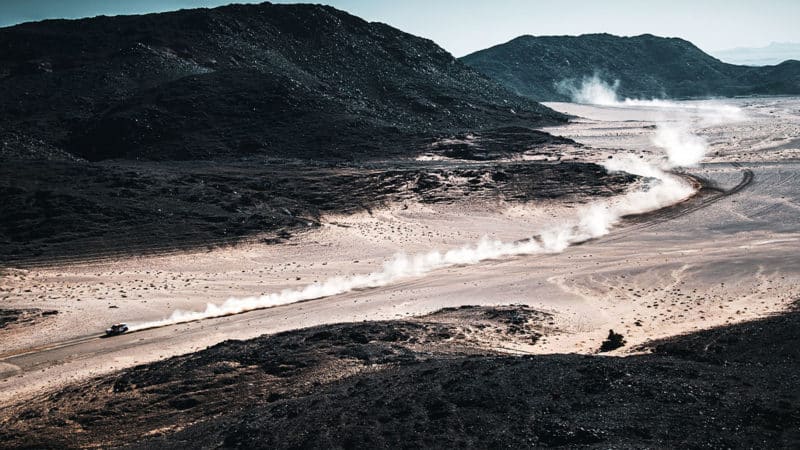
Spain’s Laia Sanz – you may know her from Extreme E – who is nicknamed Queen of the Desert makes her mark
2022
As soon as a competitive car passes by, spectators from the surrounding areas take the opportunity to start power-sliding their own 4x4s – and sometimes not even that – up and down the dunes, in and around what is ostensibly the course, with no one apparently around to stop them. It causes some hair-raising moments, leaving you to only wonder why more accidents don’t occur.
Dakar has also greater diversity in its competitors than perhaps any other motor sport. Fifty-two female competitors took part this year – held somewhat ironically in a nation where women were only allowed to drive in 2018, travel without permission from a male guardian in 2019 and only last year were allowed to live alone without permission from a male guardian. Perhaps Dakar’s presence can help continue to drive change: two female Saudi competitors were entered this year, Mashael Al-Obaidan and Dania Akeel.
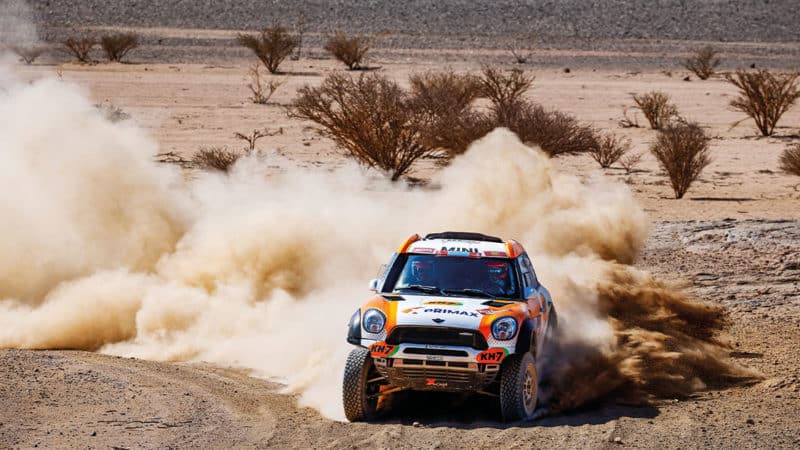
Sanz was one of 52 female competitors at Dakar
DPPI
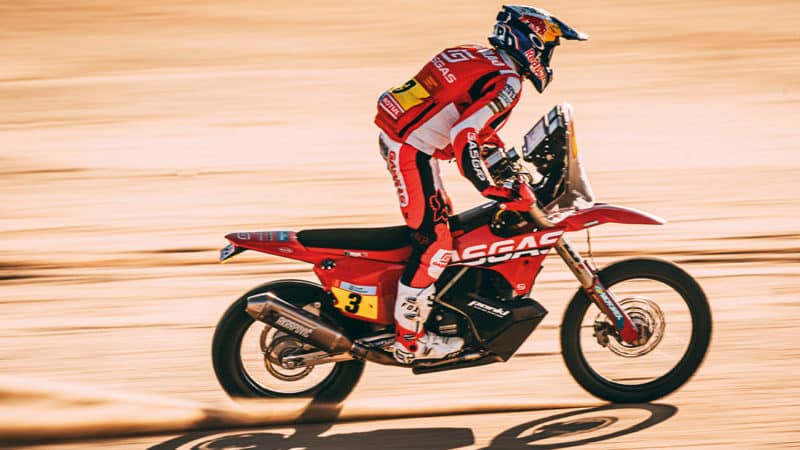
Sam Sunderland was the sole British winner. This was his second victory in the Bikes class – the first was in 2017.
DPPI
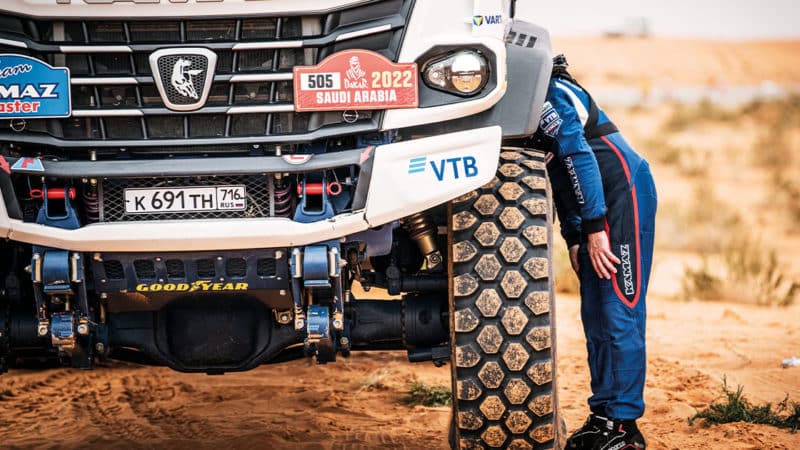
It was a ‘Russian’ 1-2-3-4 in the Trucks division, all driving Kamaz machinery
DPPI
The event is filmed and marketed rather cutely. While competitors go off into the wild for 200 miles at a time, the start and finishing line of many stages aren’t quite as ‘in the wild’ as images might lead you to believe. It may at times feel like you’ve gone full Lawrence of Arabia, but pop over the next sand dune and you’ll find a very well-used dual carriageway.
That said, the event is still brutal. French biker Pierre Cherpin was killed last year and Portuguese rider Paulo Gonçalves the season before that and there have been some sizeable shunts along the way in this year’s edition, though thankfully no one has been seriously hurt in competitive action. However, tragically, there were injuries away from the special stages. Twenty-year-old Quentin Lavalée, chief mechanic of Team 205 Africa Raid, running an Ari Vatanen Peugeot 205 T16 from 1987 in the concurrent Dakar Classic event, was killed when an assistance vehicle collided with a local truck on the final day.
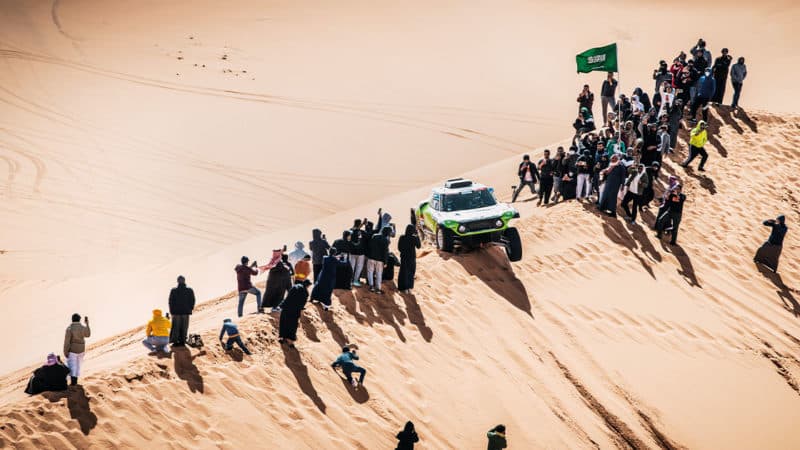
Spectators could get as close to the competitors as they pleased, as witnessed here by Sebastian Halpern in a Mini buggy. The Argentine ended the rally seventh in the Cars standings
DPPI
This came after a suspected terrorist attack which occurred the day before the rally started.
An apparent bomb was detonated under the pedals of a support vehicle driven by competitor Phillipe Boutron of Sodicars Racing, leaving him with serious leg injuries.
While Saudi police announced that there was no evidence to show the incident was the result of a malicious act, French anti-terrorism investigators decided to open a preliminary inquiry into ‘multiple attempted killings as part of a terrorist group’. “There was a charge under the side of the car that exploded – I saw everything,” said Boutron’s team boss Richard Gonzalez. “It was a deliberate act, there’s no doubt about that.”
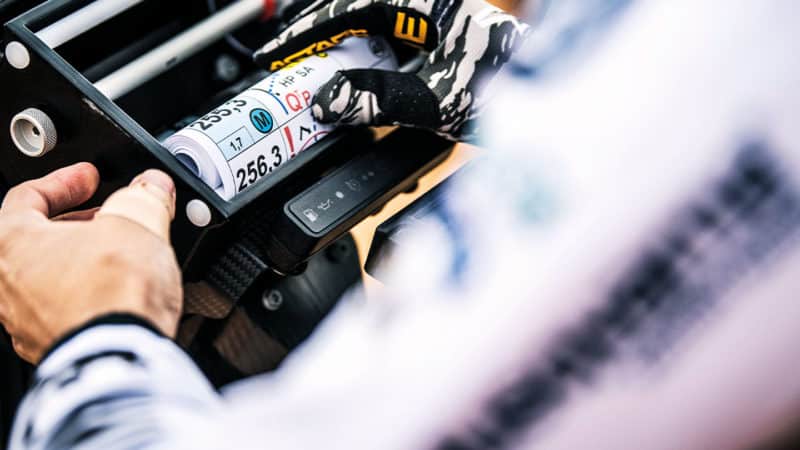
A rider checks his notes – it isn’t advisable to go missing in the Dakar Rally
DPPI
The French government’s immediate view of the event was dim. It investigates crimes against its citizens as a matter of course.
“We thought that maybe it’s best to abandon this sporting event… the question remains open,” French foreign minister Jean-Yves Le Drian said on TV.
When the idea of stopping the event was put to rally director Davide Castera, his response was, “Not at this stage – but the investigation is still on-going.”
It is to be hoped that the Dakar won’t be cancelled – simply because as a no-holds barred expression of motor sport in its purest form, there’s nothing else like it. Anyone lucky enough to stroll around the bivouac can see that. A mobile home to around 3000 people during the event, it is everything Formula 1 isn’t. Almost full access allows you to wander up to cars and peer inside, as drivers and riders mix freely with press and mechanics in a gymnasium-sized canteen.

Peterhansel was out on the opening stage with a broken axle. He was running second
DPPI
Dazzling spotlights straight out of a Hollywood film set light up the cars so those working on them can see every last crevice of the machines, happily also enabling onlookers to clearly view the beautiful machinery – both contemporary and vintage.
As for the race itself, Toyota’s Al-Attiyah ultimately prevailed in the Cars category with Loeb coming home second, half an hour off. Audi’s impressive pace was negated by those mechanical and navigation issues – Ekström finished ninth overall, Sainz in 12th and Peterhansel 57th after suffering a massive penalty due to retiring on the first day.
History was made in the Bikes class, as Britain’s Sam Sunderland dominated to claim his second victory. He is the only Brit to win any Dakar event in any category. From the futuristic Audi to Vatanen’s 205, this has been an unrivalled banquet of rallying. Just make sure you don’t get run over by a Kamaz racing truck as you wander around.
Taking on the Dakar Classic in my Dad’s Lada
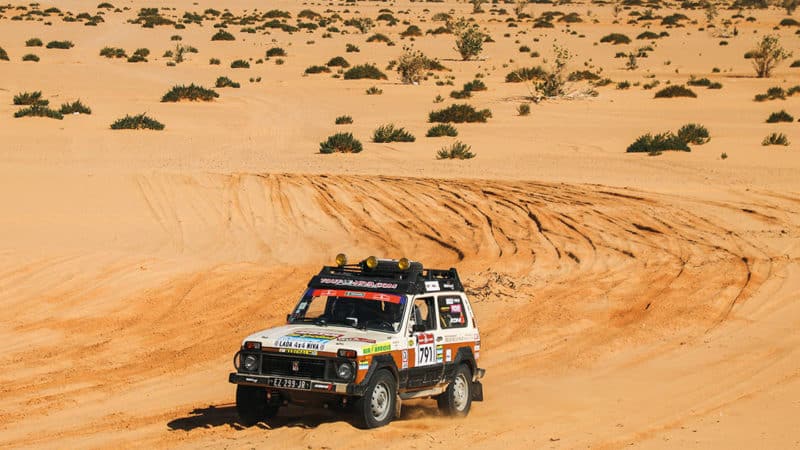
Grabowski would ultimately do his father proud, bringing home his Lada – one of the slowest vehicles entered – in 105th position. Serge Mogno took the overall win at the wheel of a 1998 Toyota Land Cruiser
DPPI
It’s one thing taking on the dangerous Dakar stages in a bespoke Prodrive Hunter or Toyota Hilux – but a Lada Niva?
The Dakar Classic, a historic rally which runs alongside the modern event – this year attracting 127 vintage machines – is one for the enthusiast’s enthusiast.
It doesn’t get more hardcore than this.
Romain Grabowski, inset, one of several die-hards taking on the event driving the Soviet Union’s favoured off-roader, says, “It’s crazy – like suddenly finding yourself part of Le Mans. You see legends like Sébastien Loeb on TV. You come here and you’re sharing the same bivouac, the same catering, and you can meet him on the road section!”
The Frenchman decided to take on the rally in a faithful reproduction of his late father’s Niva, exactly 40 years after his old man tried (and failed) to take on the fearsome original Paris-Dakar.
From the internet’s biggest Niva dealer gifting spare parts to enthusiasts turning up on his doorstep to help finish the car, Grabowski has felt lifted by the spirit of Dakar and that of his rally-mad father.
“Sometimes when you lose someone, you still believe they’re somewhere,” he says. “Coming here I have the feeling I’m sharing something with him.”
